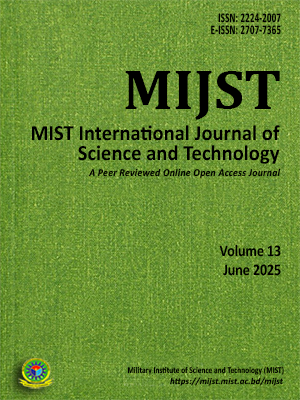A Preliminary Assessment of Power Savings by Flettner Rotors Installed on a Cargo Ship
DOI:
https://doi.org/10.47981/j.mijst.13(01)2025.508(73-82)Keywords:
Energy-efficient Shipping, Flettner Rotor, Emission Reduction, Fuel Savings, Rotor to Rotor InteractionsAbstract
In response to increasingly stringent environmental regulations by the International Maritime Organization (IMO), this study presents a preliminary assessment of Flettner rotors as a viable wind-assisted propulsion system for cargo ships. Using RANS-based Computational Fluid Dynamics (CFD), the aerodynamic performance of various rotor configurations is evaluated under different wind speeds, spin ratios, and angles of attack. Initially, an isolated 2D and 3D rotor at model scale are simulated for various operating conditions. A grid convergence study is conducted as part of the CFD results verification process. A cargo ship fitted with Flettner rotors is simulated to compute resistance and to evaluate rotor to rotor interaction. The obtained results and analyses demonstrate that, under optimal conditions, Flettner rotors have the potential to reduce fuel consumption and emissions by around 20%, significantly enhancing propulsive efficiency.
Downloads
References
Bordogna, G., Markey, D. J., Huijsmans, R. H. M., Keuning, J. A., & Fossati, F. V. (2014). Wind-assisted ship propulsion: a review and development of a performance prediction program for commercial ships. In Proceedings of the 11th International Conference on Hydrodynamics, ICHD.
Bordogna, G., Muggiasca, S., Giappinob, S., Bellolib, M., Keuninga, J. A., Huijsmans, R. H. M., & van ’t Veer, A. P. (2019). Experiments on a flettner rotor at critical and supercritical reynolds numbers. Journal of Wind Engineering and Industrial Aerodynamics, 188(1), 19–29. https://doi.org/10.1016/j.jweia.2019.02.006
Chen, W., Wang, H., & Liu, X. (2023). Experimental investigation of the aerodynamic performance of Flettner rotors for marine applications. Ocean Engineering, 281, 115006. https://doi.org/10.1016/j.oceaneng.2023.115006
Copuroglu, H. I., & Pesman, E. (2018). Analysis of flettner rotor ships in beam waves. Ocean Engineering, 150, 352–362. https://doi.org/10.1016/j.oceaneng.2018.01.004
De Marco, A., Mancini, S., Pensa, C., Calise, G., & De Luca, F. (2016). Flettner rotor concept for marine applications: A systematic study. International Journal of Rotating Machinery, 2016(1), 1–12. https://doi.org/10.1155/2016/3458750
Hirata, N., Kobayashi, H., Hino, T., Toda, Y., Abdel-Maksoud, M., & Stern, F. (2020). Experimental data for JBC resistance, sinkage, trim, self-propulsion factors, longitudinal wave cut and detailed flow with and without an energy saving circular duct. Numerical Ship Hydrodynamics, 23–51. https://doi.org/10.1007/978-3-030-47572-7_2
Hussain, M. D., & Amin, O. M. (2021). A comprehensive analysis of the stability and powering performances of a hard sail–assisted bulk carrier. Journal of Marine Science and Application, 20(3), 426–445. https://doi.org/10.1007/s11804-021-00219-w
Hussain, M. D., Karim, M. M., & Sasaki, N. (2022). Numerical assessment of the scale effects on the propulsive performance of a ship with gate rudder system. Ocean Engineering, 249, 110889. https://doi.org/10.1016/j.oceaneng.2022.110889
Hussain, M. D., Shahnewaz, M., Kabir, S., & Amin, O. M. (2018). Numerical investigation of the stability and power prediction of a sail-based wind propulsion system for a cargo ship. AIP Conference Proceedings, 1980(1). https://doi.org/10.1063/1.5044374
Joung, T.-H., Kang, S.-G., Lee, J.-K., & Ahn, J. (2020). The IMO initial strategy for reducing greenhouse gas(ghg) emissions, and its follow-up actions towards 2050. Journal of International Maritime Safety, Environmental Affairs, and Shipping, 4(1), 1–7. https://doi.org/10.1080/25725084.2019.1707938
Kolodziejski, M., & Sosnowski, M. (2025). Review of wind-assisted propulsion systems in maritime transport. Energies, 18(4), 897. https://doi.org/10.3390/en18040897
Kume, K., Hamada, T., Kobayashi, H., & Yamanaka, S. (2022). Evaluation of aerodynamic characteristics of a ship with Flettner rotors by wind tunnel tests and rans-based CFD. Ocean Engineering, 254, 111345. https://doi.org/10.1016/j.oceaneng.2022.111345
Lele, A., & Rao, K. V. S. (2017, April). Net power generated by Flettner rotor for different values of wind speed and ship speed. In 2017 International Conference on Circuit, Power and Computing Technologies (ICCPCT) (pp. 1-6). IEEE.
Li, B., Zhang, R., Zhang, B., Yang, Q., & Guo, C. (2021). An assisted propulsion device of vessel utilizing wind energy based on magnus effect. Applied Ocean Research, 114, 102788. https://doi.org/10.1016/j.apor.2021.102788
Li, J., Lin, H., Sun, C., Jiao, B., Sun, G., & Cao, F. (2024). Analysis of aerodynamic performance and application of Flettner rotor. Journal of the Institution of Engineers (India) Series C. https://doi.org/10.1007/s40032-024-01073-9
Lu, R., & Ringsberg, J. W. (2019). Ship energy performance study of three wind-assisted ship propulsion technologies including a parametric study of the flettner rotor technology. Ships and Offshore Structures, 15(3), 249–258. https://doi.org/10.1080/17445302.2019.1612544
Menter, F. R. (1994). Two-equation eddy-viscosity turbulence models for engineering applications. AIAA Journal, 32(8), 1598–1605. https://doi.org/10.2514/3.12149
Seddiek, I. S., & Ammar, N. R. (2021). Harnessing wind energy on merchant ships: Case study flettner rotors onboard bulk carriers. Environmental Science and Pollution Research, 28(25), 32695–32707. https://doi.org/10.1007/s11356-021-12791-3
Tillig, F., & Ringsberg, J. W. (2020). Design, operation and analysis of wind-assisted cargo ships. Ocean Engineering, 211, 107603. https://doi.org/10.1016/j.oceaneng.2020.107603
Traut, M., Gilbert, P., Walsh, C., Bows, A., Filippone, A., Stansby, P., & Wood, R. (2014). Propulsive power contribution of a kite and a flettner rotor on selected shipping routes. Applied Energy, 113, 362–372. https://doi.org/10.1016/j.apenergy.2013.07.026
Wang, K., Li, Z., Zhang, R., Ma, R., Huang, L., Wang, Z., & Jiang, X. (2024). Computational fluid dynamics-based ship energy-saving technologies: A comprehensive review. Renewable and Sustainable Energy Reviews, 207, 114896. https://doi.org/10.1016/j.rser.2024.114896
Downloads
Published
Issue
Section
License
Copyright (c) 2025 MIST INTERNATIONAL JOURNAL OF SCIENCE AND TECHNOLOGY

This work is licensed under a Creative Commons Attribution-NonCommercial 4.0 International License.
MIJST follows the open access policy.

This work is licensed under a Creative Commons Attribution-NonCommercial 4.0 International License. This allows anyone to copy, share, distribute, and modify the work for non-commercial purposes, where the original work and source should be properly credited.
















